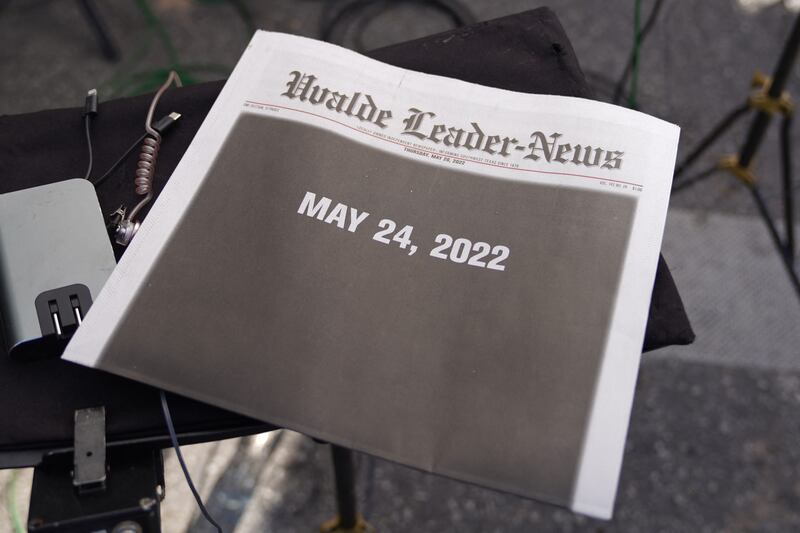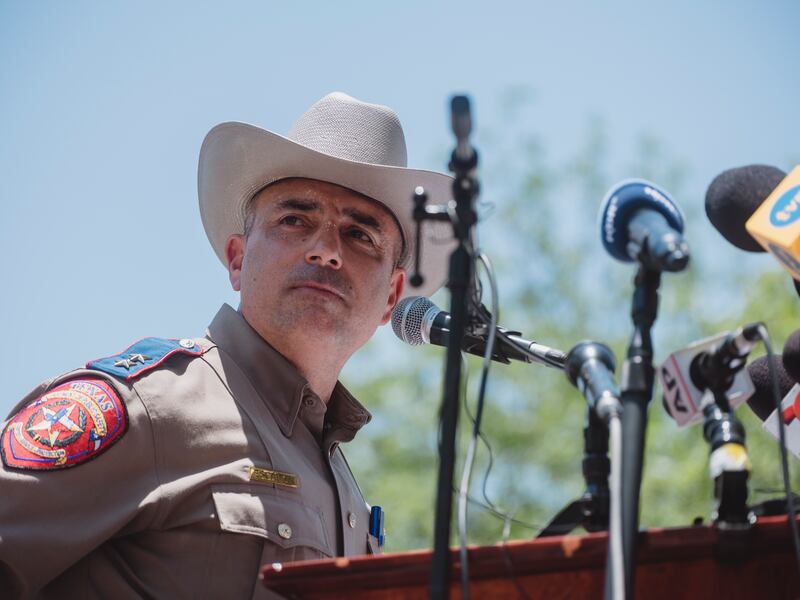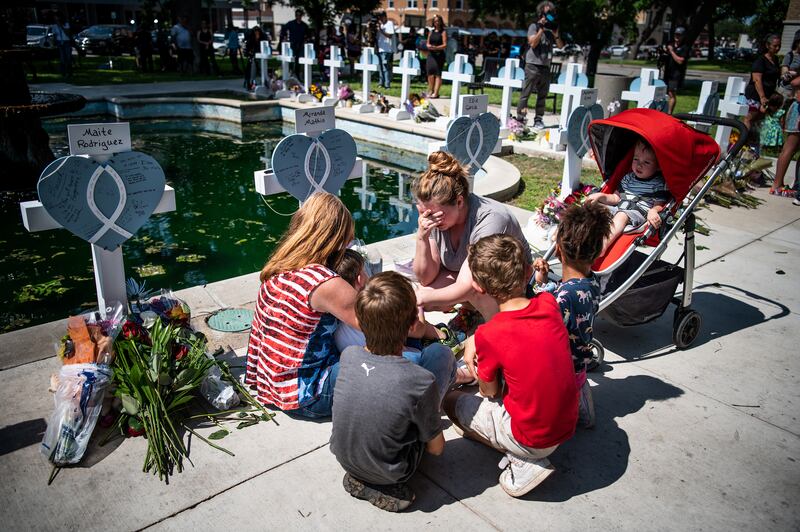There are no words.
The front page of the local newspaper, the Uvalde Leader-News, summed it up. Beneath its masthead, on the edition published on Thursday, the entire front page was just black, save for the date written in white text: May 24th, 2022.
Just after 11am on that Tuesday morning the town of Uvalde, about an hour and a half from San Antonio, changed, probably for generations.
At that time a troubled local teenager, who had purchased two assault rifles and 375 rounds of ammunition in the days after his 18th birthday earlier this month, embarked on a rampage that would become the second-worst school shooting in US history. It would leave 21 people dead; parents, families and an entire town devastated and a country wondering why these types of mass shooting keep occurring.

The carnage at Robb Elementary school, or more accurately how the police responded to the events, is posing difficult and uncomfortable questions for the law enforcement agencies in Texas. The state governor has publicly praised the police for their response. However, parents, others in the community and some politicians are now concerned about shifting official accounts and are demanding answers about whether authorities could have stormed the school earlier than they did.
Robb Elementary is about a mile from the main street in Uvalde. It is surrounded by side roads with mainly single-storey houses.
The first indication publicly that anything out of the ordinary was taking place on Tuesday morning was when a grey coloured pick-up truck veered off the road and into a ditch to the rear of the school.
The crash happened just across the street from the Hillcrest Memorial funeral home, and two of its employees were among those to rush to the scene, fearing that a car crash had taken place.
They saw a figure emerge from the passenger door carrying a rifle and a bag who then opened fire in their direction.
One of the witnesses, Albert Vargas, said: “His face was blank. There was no expression there. He looked like nothing mattered but the mission he was on. He fired the shots, ran, jumped a fence and headed towards the school.”
The incident seemed to happen completely out of the blue. However, like other mass killers in recent past, the Uvalde gunman had made his intentions known in advance on social media.
Texas governor Greg Abbott maintained at a press conference on Wednesday that gunman had made three posts on Facebook in which he said he was going to shoot his grandmother, later that he had actually shot her and then that he was going to attack a school.
Facebook’s parent company Meta disputed this assertion and maintained that he had in fact communicated privately with one individual.
In early May, a 15-year-old girl in Frankfurt, Germany had begun chatting on a social media app with an 18-year-old American from Texas, named Salvador Ramos.
In an interview with CNN, carried out with the permission of her parents, the girl said she had spoken daily with him on FaceTime.
She said she also communicated with him via a social live-streaming app called Yubo and played games with him on a gaming app named Plato. In their conversations, she said he asked about her life in Germany. “He looked happy and comfortable talking to me,” the girl said. She said he told her that he spent a lot of time alone at home.
However, there were some comments that caused alarm.
In one case, she said, he told her that he “threw dead cats at people’s houses”.
She said she got the impression that he kept to himself.
Ramos, by all accounts, was a troubled individual with few friends.
Most recently he had been living with his grandmother in Uvalde. US media reports suggested that his mother had drug problems.
There were reports that he had a speech impediment and that he had been mocked and bullied in school.
He appeared to have sought social interactions online, using the Yubo app, participating in live streaming rooms and meeting others, virtually, to chat and play games.
Ramos reached his 18th birthday in mid-May and within days had legally bought two assault rifles and ammunition. He posted a picture of his new collection on Instagram.
On Tuesday, messages sent to the girl in Frankfurt suggested that he had an issue with his grandmother and that events were about to spiral out of control.
Ramos complained about his grandmother being “on the phone with AT&T abojt [sic] my phone”.
“It’s annoying,” he texted.
Six minutes later, he texted: “I just shot my grandma in her head.”
In a final message to the girl sent at 11.21am in Texas he said: “Ima go shoot up a[n] elementary school rn [right now].”
[ Grieving husband of teacher killed in Texas school shooting collapses and diesOpens in new window ]
Just after 1pm on Thursday Victor Escalon jnr, regional director of the Texas Department of Public Safety, stood in the middle of the street outside Robb Elementary School and gave a remarkable press conference. He wanted to set out the chain of events as authorities now knew them.
He said that Ramos had shot his grandmother in the face and had fled in a pickup truck which crashed close to the school perimeter at 11.28 on Tuesday morning.
At 11.30am police received their first emergency call with reports that a man had crashed a vehicle and was carrying a gun.
Escalon said the gunman, after firing on the men at the funeral home, had climbed a fence and entered the school building “unobstructed”.
The problem was that, the day before, the official story from authorities in Texas was that a security guard or campus officer had “engaged” the gunman outside the school. However, there was no campus officer and earlier reports that a guard had been shot and wounded were incorrect.

Another issue was that the school district safety policy stipulated that class doors should be locked.
Escalon said that law enforcement officers entered the school at 11.40am – about four minutes behind the gunman. He suggested that they came under fire and did not attempt to storm the classroom in which Ramos barricaded himself.
He said officers had assisted in the evacuation of other staff and students.
However, in the classroom in which he had entered, Ramos killed 19 students and two teachers. Most of the children were about 10 years of age.
It was an hour before US Border Patrol tactical teams with specialist equipment arrived on the scene. They shot Ramos dead.
Since the Columbine school attack in 1999, the official policy among many police forces in the US has evolved and now calls on officers to go after gunmen immediately so as to try to save more lives rather than waiting for specially-trained backup.
The problem for authorities in Texas is that videos have emerged of parents arguing with police outside the school in the hour during which the gunman was left in the classroom and urging them to act.
One father told the Associated Press that he and other bystanders had considered running into the school themselves.
One woman told the Wall Street Journal that she had been briefly handcuffed and accused of impeding a police investigation after demanding that they enter the building after the gunman.
On Friday, the head of the Texas Department of Public Safety Col Steven McCraw dropped a bombshell.
While young children inside the room were ringing 911 pleading for the police to help them as the gunman was in the room, officers were in the hallway outside waiting for specialist back up.
The local commander on the scene had made a wrong call, he said.
On Sunday, US president Joe Biden will visit Uvalde where he will spend a lot of time consoling the families of the victims.
The bodies of the 19 children have been released by authorities for burial and funerals are likely to commence soon.

In another heartbreak for one of the bereaved families, the husband of one of the teachers killed in the shooting on Tuesday died suddenly while making her funeral arrangements.
Biden is likely again to press politicians in Washington to introduce measures to curb the soaring levels of gun violence.
Republicans have strongly resisted all moves up to now to limit gun rights. In fact, laws surrounding the carrying of weapons have been loosened in some states.
Ironically, one the main gun rights organisations, the NRA, is holding a big conference in Houston, about four hours from Uvalde, this weekend. Former president Donald Trump is scheduled to speak at it.
On Capitol Hill, Democrat and Republican senators will hold talks over the coming days on whether new legislation on issues such as red flag warnings about sales of guns to potentially dangerous individuals could be introduced. Sceptics fear that as soon as the heat over the Uvalde shootings dies aweay, the impetus will go out of this process.
In the Uvalde County arena, a couple of miles outside of the town, on Wednesday night, several hundred local people and politicians turned up for a vigil to mourn the deceased, watched by dozens of reporters, camera crews and photographers from around the world.
The event was primarily religious. Pastors spoke about the healing spirit of God. They read passages from the Bible and sang hymns. Some of those attending stood in circles, hugging and praying. Guns or gun controls were not mentioned.
The vigil was the first time that some of the families of the children who had been killed had spoken publicly.
Jessica Hernandez spoke about her daughter Alithia Ramirez who had wanted to be an artist. She brought along some cards she had made for her on her birthday last year.
She said she wanted to see more security in schools.
“I do not want this to happen again. I do not want this to happen to other families. I just don’t.”
















